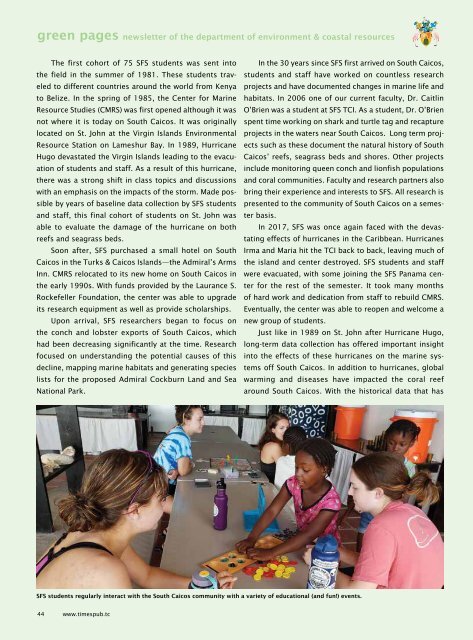Times of the Islands Spring 2021
Presents the "soul of the Turks & Caicos Islands" with in-depth features about local people, culture, history, environment, real estate, businesses, resorts, restaurants and activities.
Presents the "soul of the Turks & Caicos Islands" with in-depth features about local people, culture, history, environment, real estate, businesses, resorts, restaurants and activities.
You also want an ePaper? Increase the reach of your titles
YUMPU automatically turns print PDFs into web optimized ePapers that Google loves.
green pages newsletter <strong>of</strong> <strong>the</strong> department <strong>of</strong> environment & coastal resources<br />
The first cohort <strong>of</strong> 75 SFS students was sent into<br />
<strong>the</strong> field in <strong>the</strong> summer <strong>of</strong> 1981. These students traveled<br />
to different countries around <strong>the</strong> world from Kenya<br />
to Belize. In <strong>the</strong> spring <strong>of</strong> 1985, <strong>the</strong> Center for Marine<br />
Resource Studies (CMRS) was first opened although it was<br />
not where it is today on South Caicos. It was originally<br />
located on St. John at <strong>the</strong> Virgin <strong>Islands</strong> Environmental<br />
Resource Station on Lameshur Bay. In 1989, Hurricane<br />
Hugo devastated <strong>the</strong> Virgin <strong>Islands</strong> leading to <strong>the</strong> evacuation<br />
<strong>of</strong> students and staff. As a result <strong>of</strong> this hurricane,<br />
<strong>the</strong>re was a strong shift in class topics and discussions<br />
with an emphasis on <strong>the</strong> impacts <strong>of</strong> <strong>the</strong> storm. Made possible<br />
by years <strong>of</strong> baseline data collection by SFS students<br />
and staff, this final cohort <strong>of</strong> students on St. John was<br />
able to evaluate <strong>the</strong> damage <strong>of</strong> <strong>the</strong> hurricane on both<br />
reefs and seagrass beds.<br />
Soon after, SFS purchased a small hotel on South<br />
Caicos in <strong>the</strong> Turks & Caicos <strong>Islands</strong>—<strong>the</strong> Admiral’s Arms<br />
Inn. CMRS relocated to its new home on South Caicos in<br />
<strong>the</strong> early 1990s. With funds provided by <strong>the</strong> Laurance S.<br />
Rockefeller Foundation, <strong>the</strong> center was able to upgrade<br />
its research equipment as well as provide scholarships.<br />
Upon arrival, SFS researchers began to focus on<br />
<strong>the</strong> conch and lobster exports <strong>of</strong> South Caicos, which<br />
had been decreasing significantly at <strong>the</strong> time. Research<br />
focused on understanding <strong>the</strong> potential causes <strong>of</strong> this<br />
decline, mapping marine habitats and generating species<br />
lists for <strong>the</strong> proposed Admiral Cockburn Land and Sea<br />
National Park.<br />
In <strong>the</strong> 30 years since SFS first arrived on South Caicos,<br />
students and staff have worked on countless research<br />
projects and have documented changes in marine life and<br />
habitats. In 2006 one <strong>of</strong> our current faculty, Dr. Caitlin<br />
O’Brien was a student at SFS TCI. As a student, Dr. O’Brien<br />
spent time working on shark and turtle tag and recapture<br />
projects in <strong>the</strong> waters near South Caicos. Long term projects<br />
such as <strong>the</strong>se document <strong>the</strong> natural history <strong>of</strong> South<br />
Caicos’ reefs, seagrass beds and shores. O<strong>the</strong>r projects<br />
include monitoring queen conch and lionfish populations<br />
and coral communities. Faculty and research partners also<br />
bring <strong>the</strong>ir experience and interests to SFS. All research is<br />
presented to <strong>the</strong> community <strong>of</strong> South Caicos on a semester<br />
basis.<br />
In 2017, SFS was once again faced with <strong>the</strong> devastating<br />
effects <strong>of</strong> hurricanes in <strong>the</strong> Caribbean. Hurricanes<br />
Irma and Maria hit <strong>the</strong> TCI back to back, leaving much <strong>of</strong><br />
<strong>the</strong> island and center destroyed. SFS students and staff<br />
were evacuated, with some joining <strong>the</strong> SFS Panama center<br />
for <strong>the</strong> rest <strong>of</strong> <strong>the</strong> semester. It took many months<br />
<strong>of</strong> hard work and dedication from staff to rebuild CMRS.<br />
Eventually, <strong>the</strong> center was able to reopen and welcome a<br />
new group <strong>of</strong> students.<br />
Just like in 1989 on St. John after Hurricane Hugo,<br />
long-term data collection has <strong>of</strong>fered important insight<br />
into <strong>the</strong> effects <strong>of</strong> <strong>the</strong>se hurricanes on <strong>the</strong> marine systems<br />
<strong>of</strong>f South Caicos. In addition to hurricanes, global<br />
warming and diseases have impacted <strong>the</strong> coral reef<br />
around South Caicos. With <strong>the</strong> historical data that has<br />
SFS students regularly interact with <strong>the</strong> South Caicos community with a variety <strong>of</strong> educational (and fun!) events.<br />
44 www.timespub.tc

















